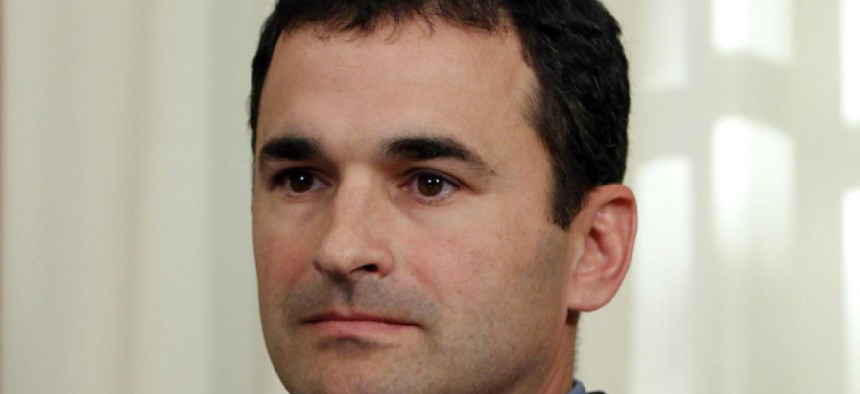
OMB Controller Danny Werfel touts progress on recommendations from last year. Charles Dharapak/AP
Watchdog finds tens of billions in cost cutting opportunities
GAO report outlines 51 areas where federal programs could be more efficient.
This story has been updated.
The Government Accountability Office on Tuesday issued a report identifying many overlapping or wasteful government functions, saying the government potentially could save tens of billions of dollars annually if the right remedies were pursued.
The second of such annual reports, the 426-page document outlined 51 areas in government where programs can achieve greater efficiencies, including 32 with evidence of duplication, overlap or fragmentation. GAO had identified 81 areas for savings in its 2011 report and reviewed the past year’s progress on its recommendations.
Among the examples of overlapping functions GAO found were 53 programs run by four separate agencies to provide entrepreneurs with economic development assistance, as well as $79 billion spent on more than 7,200 investments in information technology. GAO also outlined 18 other cost-cutting measures, including selling off excess uranium and replacing the $1 bill with the $1 coin.
The House Oversight and Government Reform Committee held a hearing Tuesday morning to address the report. Chairman Darrell Issa, R-Calif., released a statement saying, "I have always said that the enemy isn't the Democrats, the enemy isn't the Republicans -- it's the bureaucracy."
Comptroller General Gene Dodaro told the committee that “identifying, preventing and addressing unnecessary duplication, overlap and fragmentation” is difficult because it “may require agencies and Congress to re-examine within and across various mission areas the fundamental structure, operation, funding and performance of a number of long-standing federal programs or activities with entrenched constituencies.”
He encouraged Congress and agencies to set outcome-oriented goals -- particularly in cross-cutting policy areas -- as called for in the 2010 Government Performance and Results Act Modernization Act. And though the new GAO report was finalized before President Obama released his fiscal 2013 budget on Feb. 13, Dodaro praised the administration’s new requirement that agencies set priority goals.
Sen. Tom Coburn, R-Okla., testifying on the House side as a specialist in reducing government waste, blamed Congress for the meager progress on removing duplication. “Like last year’s report, which identified more than $100 billion in budgetary savings by simply eliminating duplicative programs, today’s findings are a testament to failed congressional efforts of oversight and a reminder Congress continues to shirk its duty to address even blatant areas of waste and mismanagement of taxpayer funding,” he said.
The problem with Congress is less that it’s partisan than its members are concerned about the next election, he said, adding: “We lack courage and leadership to do what’s in the country’s long-term interest.”
Coburn proposed lawmakers include a metric for program performance in all legislation and require a sunset provision for every program. He complained that most agencies can’t compile a list of all their programs, the exception being the Education Department, which does an annual inventory.
Ranking member Rep. Elijah Cummings, D-Md., expressed wishes that the debate “steer clear of politically charged rhetoric that condemns the entire government as ‘obese’ or ‘bloated,’ [and] honor the millions of federal workers who do so much for this country on a daily basis.”
Office of Management and Budget Controller Danny Werfel earlier in the day touted the Obama administration’s record on responding to GAO’s recommendations, saying in a statement that nearly 80 percent of the issues GAO raised in 2011 have been addressed in some way. Lawmakers, however, addressed only 39 percent of the recommendations that required congressional action, according to Werfel.
GAO broke down the figures even further, noting that only 4 percent of 2011’s areas of recommendation were completely addressed, and the remainder were partially implemented or not touched on at all.
Werfel said the administration is taking “aggressive action” to streamline government as part of its Campaign to Cut Waste, including consolidating 1,200 data centers by the end of 2015 and cutting real estate costs across civilian agencies by more than $3 billion by the end of 2012.
Gabi Dechter, managing director for economic policy at the nonpartisan think tank Center for American Progress, released a statement mentioning the president’s trade reorganization plans, which include consolidating six business-focused agencies into one.
“In order for this and other reforms to happen, Congress must give the president the same fast-track consolidation authority enjoyed for more than 50 years by presidents Hoover through Reagan,” Dechter said. “The time to act is now.”
Sen. Tom Carper, D-Del., chairman of the Senate Homeland Security and Governmental Affairs Subcommittee on Federal Financial Management, released a statement Tuesday in response to the report, calling it “disappointing, but not surprising.”
Carper pointed to initiatives like the Campaign to Cut Waste as steps in the right direction, but added that “the administration cannot do this alone -- we in Congress must do more work on our part to achieve success.”
NEXT STORY: Santorum argues for religion in government






